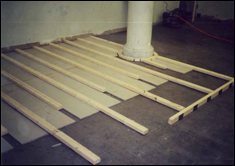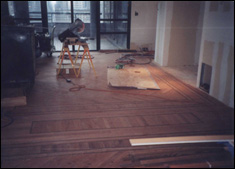|
What type of hardwood flooring will work best for
my New York City apartment? What makes one type of wood flooring
better than another? How durable will my new floor be? What is graining?
What does it mean for a floor to be pre-finished?
All of these are questions that will have an impact
on the aesthetics and functionality of your new wood floor. There
are a number of definitions and terms that will help you when trying
to determine what kind of hardwood floor will work best for your
apartment. Here are some of them.
Engineered/Solid
Wood flooring products can be constructed in one of two ways: engineered
or solid. The simpler and more cost-effective type of flooring is
solid. It is simply wood directly from the tree fashioned into a
board or tile with typically a tongue-groove for linking pieces
to each other. This type of floor can have a finish applied at the
factory or after the installation is completed.
An engineered floor has a more complex structure
consisting of a number of pieces of thin plywood with a thin layer
of actual wood on top. This type of floor is finished at the factory
and is typically more expensive than a solid wood product.
So what's the difference? A solid wood floor will
expand and contract depending on how much humidity there is in the
air causing small gaps between the individual tiles/boards. This
"gapping" due to expansion/contraction is almost non-existent
with an engineered wood flooring product. Also, an engineered floor
withstands water damage much better. Where a solid wood floor would
buckle and pull away from the underlying sub-floor after a flood
(requiring disposal and a new installation) an engineered floor
can usually be salvaged.
Species
The species of the wood can have an effect on graining, color,
and hardness. The most common species are ones such as oak,
maple, and cherry, but a floor can made from basically any wood.
There is exotic wood flooring available that can have a certain
grain or hue that some people find very appealing. These might
include kempas, merbau, or even olive. |
|
 |
|
Finish
The finish is sometimes called polyurethane or urethane and can
be water- or oil- based. This is a protective layer put on a floor
after installation. Some floors come pre-finished; see below for
more details. Most apartment building in Manhattan require hardwood
flooring to be finished with a water-based urethane due to the strong
fumes given off by an oil-based product. The finish can come in
a variety of different sheens (how glossy it is) including matte
(flat), semi-gloss (some sheen), or gloss (high sheen). Remember,
with a high gloss you will see every imperfection in the floor;
our recommendation is usually a flat finish.
Strip/Plank
A strip is a straight wood flooring board that is less 2 ¼"
in width. Anything wider than that is called a plank. A plank can
give a different feel to a room, but is in general just a wider
version of a strip.
Parquet
Parquet is a hardwood product fashioned into the shape of a tile.
They come in a variety of flavors (see our Gallery for pictures)
and are usually less expensive than other wood flooring products.
Stain
During a resurfacing, the stain is the first finishing application
made. Stains can come in a variety of shades as seen below on the
stain swatch. There is also a process called bleaching/pickling
during which the natural coloration is bleached out of the floor
and pickling stain is applied. This process is used to get a more
uniform color without showing the natural graining of the floor.
Graining
Graining is one of the major characteristics which defines a wood
species. Graining can also be dependent upon the grade of wood you
select. The higher the grade of wood, the less graining and more
consistency you'll see.
Sub-Floor Preparation
A sound, properly prepared sub-floor is the first step to new hardwood
floor installation. Acting like the foundation of a house, your
new hardwood floor will rest directly on and receive a fair portion
of its strength and durability from the sub-floor.
| The most
common sub-floor encountered in apartment buildings in New York
City - and in particular Manhattan - is called a concrete slab.
This is possibly the most solid sub-floor to install on top
of, and when properly prepared allows for a beautiful finished
product. To prepare a concrete slab for hardwood floor installation,
the floor should be scraped and have any grease, oil, stains,
or dust removed. An engineered wood floor can be glued down
directly onto the concrete slab. If you prefer a solid wood
product, a layer of plywood would have to be installed on top
of the slab. |
|
 |
|
While most New York City apartments have concrete
slab sub-floors, most pre-war buildings have wood sub-floors. Before
we can begin a new hardwood installation on floor in a pre-war apartment
in Manhattan, there are typically repairs to the sub-floor that
need to be dealt with. After these repairs are made, the new installation
can be of an engineered or solid wood product.
|